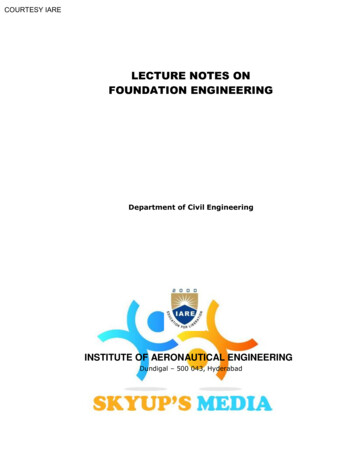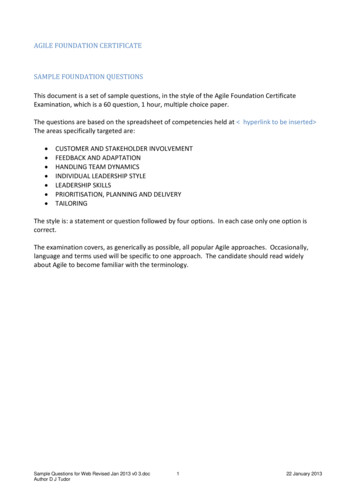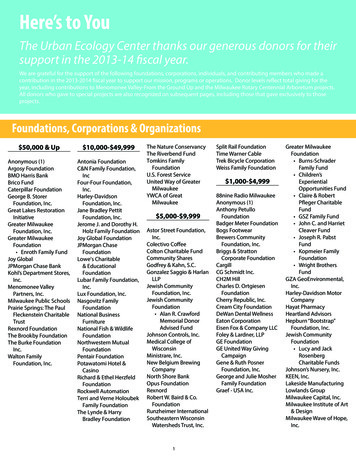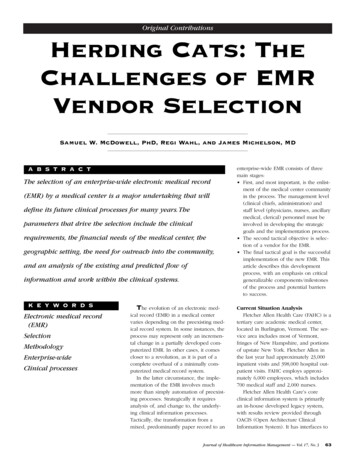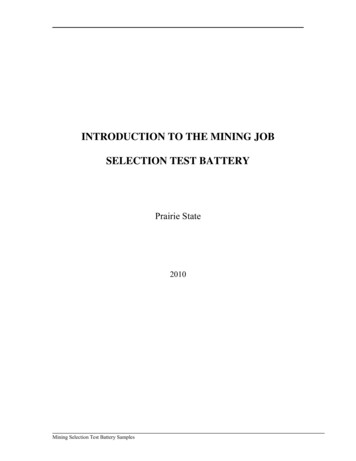
Transcription
FY1 Job AnalysisAppendix DImproving Selection to theFoundation ProgrammeAppendix DFY1 Job AnalysisISFP Final ReportPage 125
FY1 Job AnalysisAppendix DISFP Final ReportPage 126
FY1 Job AnalysisAppendix DFY1 Job Analysis ReportImproving Selection to the FoundationProgrammeWork Psychology Group and the University of CambridgeProfessor Fiona PattersonVicki ArcherDr Maire KerrinVictoria CarrLouise FaulkesPhillipa CoanDr David GoodFinal ReportJuly 2010ISFP Final ReportPage 127
FY1 Job AnalysisAppendix DAcknowledgementsThis project was conducted by the Work Psychology Group in collaboration with the University ofCambridge on behalf of the Improving Selection to the Foundation Programme Project Group. TheISFP Project Group, Chaired by Professor Paul O’Neill, includes representatives from fifteenorganisations: the Academy of Medical Royal Colleges (AoMRC), the British Medical Association(BMA) Medical Students Committee, the Conference of Postgraduate Medical Deans (CoPMED), thefour UK Departments of Health, the General Medical Council (GMC), the Medical Schools Council,the Northern Ireland Medical and Dental Training Agency (NIMDTA), NHS Education for Scotland(NES), NHS Employers (NHSE), the Scottish Board for Academic Medicine, the UK FoundationProgramme Office (UKFPO) and clinical tutors. The ISFP Project is funded by the Department ofHealth.The Co‐directors of the project to develop a Situational Judgement Test for ISFP are Professor FionaPatterson and Dr David Good. The core project team consisted of Professor Fiona Patterson, VickiArcher, Dr Maire Kerrin, Victoria Carr, Louise Faulkes and Phillipa Coan in conjunction with theMedical Schools Council project team including Professor Paul O’Neill, Professor Tony Weetman, DrKatie Petty‐Saphon, Dr Denis Shaughnessy, Siobhan Fitzpatrick and Amy Stringer.The project teams would like to thank the Cambridge University Hospitals NHS Foundation Trust,University Hospital of South Manchester NHS Foundation Trust and NHS Highland in Scotland forenabling insightful shadowing of Foundation doctors. We are especially grateful to staff at theUKFPO, AoMRC and UK medical schools for facilitating the research, and to the individualFoundation School Directors and Managers, Foundation Programme Directors, Foundation doctors,Medical School Education Deans, Consultant clinical tutors and patient representatives who sharedtheir time and expertise. We would like to add a personal thank you to Dr Alys Burns, East of EnglandDeanery; Dr Ian Curran, London Deanery; Lynne Hobbs, Methods; Professor Stephen Powis, RoyalFree Hampstead NHS Trust; and Dr Kim Walker, NHS Education for Scotland, for their contributionsto this research.FY1 Job Analysis Report In confidence to Medical Schools CouncilISFP Final ReportPage 128
FY1 Job AnalysisAppendix DContents1.Executive Summary . 12Introduction . 3345.6.2.1Purpose of the job analysis . 32.2Structure of this report . 3Job Analysis . 43.1Introduction . 43.2Job analysis approach . 43.3Literature review . 63.4Semi‐structured interviews . 83.5Observations (Shadowing) . 113.6Validation questionnaire . 12Analysis of the Data . 144.1Analysis strategy for the interviews . 144.2Creation of the template . 154.3Analysis strategy for the observations . 154.4Validation of Professional Attributes Framework. 15Results of Job Analysis . 185.1Professional Attributes Framework . 185.2Findings from the literature review . 185.3Findings from the interviews . 295.4Findings from observations. 325.5Findings from validation questionnaire . 335.6Summary of findings . 365.7Mapping on to existing material . 37Situational Judgement Test Design Specification . 416.1SJT literature review . 416.2Purpose of the test. 426.3Target attribute domains for the SJT . 436.4Context . 476.5Item selection methodology . 476.6Response formats . 486.7Test length. 496.8Test structure . 496.9Scoring key . 49FY1 Job Analysis Report In confidence to Medical Schools CouncilISFP Final ReportPage 129
FY1 Job Analysis6.10Appendix DMultiple forms . 507.Summary and Conclusions . 518.References . 52Appendix 1: Literature Review Specification & Search Strategy . 55Appendix 2: Job Analysis Participant Briefing . 59Appendix 3: FY1 Doctor Job Analysis Questions . 61Appendix 4: Patient Representative Briefing . 63Appendix 5: Observation Observe and Record Sheet . 65Appendix 6: Foundation Year One Doctor Professional Attributes Questionnaire . 66Appendix 7: Foundation Programme Commencing August 2010 . 69Appendix 8: FY1 Literature Review Table . 71Appendix 9: Situational Judgement Test ‐ Literature Review Table . 83Appendix 10: Project Team Biographies . 104FY1 Job Analysis Report In confidence to Medical Schools CouncilISFP Final ReportPage 130
FY1 Job AnalysisAppendix D1.Executive Summary1.1The purpose of the job analysis was to define the professional attributes (as opposed toclinical knowledge and skills) that are expected in the role of a Foundation Year One (FY1)doctor. The results will be used to determine the target domains (and test specification) forthe SJT which will be used alongside a measure of educational attainment (EducationalPerformance Measurement) for selection to the Foundation Programme.1.2A systematic, multi‐method job analysis, which incorporated a literature review, semi‐structured critical incident interviews and observations, was carried out. This triangulationapproach was used to increase the credibility and validity of the results.1.3The literature review, which covered all existing policy documentation and relevantpublications, was conducted in two parts. The first part aimed to identify the key skills andprofessional attributes of a FY1 doctor.1.4Part two of the literature review focussed on Situational Judgement Tests (SJTs) and theiruse in high stakes selection. The results help to put the purpose of the job analysis incontext and aid an understanding of the methodology that will be undertaken whendeveloping the SJT.1.5In all, 51 semi‐structured interviews were carried out with Foundation doctors,clinical/educational supervisors, Directors/Deans/Heads of Medical Education at MedicalSchools, Trust Medical Directors, Foundation School and Programme Directors and patientrepresentatives. The interviews were conducted face to face or by telephone and lastedbetween 30‐45 minutes. Interviewees were asked for examples of specific incidents from theFY1 job that were characteristic of effective or non‐effective performance, and thus toidentify the key skills and attributes needed to perform as a FY1 doctor.1.6Observations (shadowing) of FY1 doctors were carried out at four locations throughout theUK. 13 FY1 doctors were observed. A total of 29 hours of observations were undertaken bytwo researchers. The purpose of observing FY1 doctors was to gain a greater insight andunderstanding into the tasks and responsibilities of a FY1 doctor, as well as the professionalattributes required to perform the role successfully. The researchers recorded the tasks,responsibilities, behaviours and attributes of the FY1 doctor. A record was kept of thetimings of actions and behaviours to gain an understanding of the temporal nature of therole.1.7A survey was conducted to validate the outcomes of the job analysis with a larger number ofindividuals. The validation survey was sent to a number of different organisations (with arequest for it to be cascaded) and individuals, including; the BMA Junior Doctors Committee,the UKFPO Foundation Doctors Advisory Board and the UKFPO Foundation School Directorsand Managers. 230 individuals responded.1ISFP Final ReportPage 131
FY1 Job AnalysisAppendix D1.8The interview transcripts were analysed using template analysis11 to identify the key themeswithin the data. All 51 transcripts were coded according to an initial template. The templateunderwent a number of iterations, and quality checks were carried out at after half of thetranscripts had been coded.1.9The observations were analysed and the behaviours classified according to the template.Where behaviours could not be associated with existing classifications in the template, newclassifications were introduced.1.10Analysis of the data from the interviews and observations resulted in nine professionalattributes being defined, namely: (1) Commitment to Professionalism, (2) Coping withPressure, (3) Effective Communication, (4) Learning and Professional Development, (5)Organisation and Planning, (6) Patient Focus, (7) Problem Solving and Decision Making, (8)Self Awareness and Insight and (9) Working Effectively as Part of a Team. These were set outin a ‘Professional Attribute Framework’ which lists the behavioural descriptors that arerepresentative of each attribute.1.11The contents of the Professional Attributes Framework were checked against the findingsfrom the first part of the literature review. This confirmed that all of the professionalattributes identified through the review had already been identified through the other twojob analysis methods (i.e. interviews and observations), thus confirming the validity of theFramework.1.12The results from the validation survey indicated that all nine Professional Attributes wererated as important for a FY1 doctor and important to evaluate at selection.1.13The Professional Attributes Framework was mapped against existing data, including the FY1Person Specification and the FY1 Curriculum. The mapping demonstrated that the jobanalysis results and the resultant Professional Attributes Framework showed goodconcordance with the UKFPO FY1 Person Specification, although the Professional AttributesFramework identified one attribute; Learning and Professional Development that is notpresent in the FY1 Person Specification. The mapping also demonstrated good concordancebetween the Professional Attributes Framework and the FY1 Curriculum.1.14This report outlines the design specification for the SJT. Section 6 details the SJT targetattribute domains, the length of the test, response formats and the test structure.1.15In conclusion, the job analysis has resulted in a Professional Attributes Framework whichidentifies the professional attributes that are important for a FY1 doctor, and provides targetattribute domains for the SJT. It is recommended that the detail provided within theProfessional Attributes Framework is used going forward to assist in the development of theexisting FY1 Person Specification.2ISFP Final ReportPage 132
FY1 Job AnalysisAppendix D2Introduction2.1Purpose of the job analysis2.1.1This report outlines the methodology and results of a job analysis carried out to support thedevelopment of a Situational Judgement Test (SJT) for the selection of trainee doctors ontothe Foundation Programme. The purpose of the job analysis was to define the professionalattributes (as opposed to clinical knowledge and skills) that are required by the role of theFoundation Year One (FY1) doctor. The results are used to determine the target domains forthe SJT and will be used to inform the test specification.2.1.2The outcomes of this analysis are described in behavioural terms in the form of a‘Professional Attributes Framework’, which sets out the key dimensions and exampledescriptors of effective performance in the role.2.1.3The SJT will be used alongside a measure of educational attainment (EducationalPerformance Measurement, or EPM) which will measure clinical skills and knowledge. TheEPM is not within the remit of this report.2.2Structure of this reportThis report has four main sections: Section 3 describes the job analysis methodology and research conducted to identifythe professional attributes that are judged as important by a range of stakeholders for aFY1 doctor. Section 4 provides an outline of the data analysis methodology employed. Section 5 describes the findings from the job analysis, and provides a framework of thekey professional attributes (with associated behavioural descriptors) for the FY1 doctor(Professional Attributes Framework). The content validity of this framework isillustrated by showing how these attributes map onto existing policy documentation,including the Foundation Programme curriculum. Section 6 presents in detail the design specification for the Situational Judgement Testand provides a matrix of the target domains and example scenarios. A summary and conclusions are provided in Section 7. Further materials relevant tosections of the report are provided in the Appendices.3ISFP Final ReportPage 133
FY1 Job AnalysisAppendix D3Job Analysis3.1Introduction3.1.1The cornerstone of an effective selection system is a thorough analysis of the relevantknowledge, skills, attitudes and other personal qualities associated with successfulperformance in a given role, as this enables accurate identification of domains to betargeted at selection.3.1.2Job analysis is a systematic process for collecting and analysing information about jobs.When properly conducted, a job analysis provides objective evidence of the skills andabilities needed for effective job performance and thus provides support for the use ofselection procedures measuring those skills and abilities. As such, a comprehensive jobanalysis is typically regarded as best practice as a first step in designing any selection system.Research evidence also shows that conducting a job analysis is important for an organizationto defend its human resource management practices against legal challenge1.3.1.3As the name suggests, a job analysis should be analytical, meaning that the job analysisprocess should break down the job into its main component parts rather than describing thejob as a whole. The end result of the job analysis should be a documented, structured, andthorough report which outlines the essential requirements of the job2.3.1.4For purposes of inclusion, diversity, and buy‐in from stakeholders, it is important to gatherinformation from a range of individuals. By gathering a diversity of opinions and views, anaccurate and representative description of the job is more likely to be reached2.3.1.5There is no given rule for the number of individuals who should participate in a job analysis,however guidance is provided on the acceptable number of participants needed to obtainreliable and accurate information about a job3. For a job that has a population of around8000 (as does the F1 role in the UK), 40 individuals should be involved in the process toobtain 80% confidence in the results. To obtain 90% confidence in the results, 100individuals should be involved in the entire job analysis process, including interviews,observations and respondents to surveys.3.1.6Job analysis is a process and not a single methodology. There are multiple ways to gatherand analyse job information. Best practice advises a multi method approach to job analysis,which gathers information from multiple sources using multiple means, as this allowsidentification of aspects of a job that may not be accessible through a single methodology4.Data collected from multiple sources also prevents potential biases from a single source5 andusing multiple methods allows for convergence of results to make the job analysis morecomprehensive6.3.2Job analysis approach3.2.1In this study, a previously validated multi‐method job analysis approach was followed7,8. Thejob analysis methods used included:4ISFP Final ReportPage 134
FY1 Job Analysis3.2.2Appendix D a full literature review of existing research and relevant policy documentation Semi‐structured critical incident interviews with individuals familiar with the role of aFY1 doctor, including Foundation School Directors and Educational Supervisors, as wellas Foundation Doctors and patient representatives Direct observations (shadowing) of FY1 doctors in the workplace, using structuredchecklists A validation questionnaire‐based survey that asked respondents (a range ofstakeholders) to rate the relative importance of each of the professional attributes andthe importance of assessing/evaluating each attribute at the point of selectionFigure 1 below depicts the multi‐method approach used and demonstrates how the resultsfrom the individual methods are to be triangulated. Triangulation is a technique that refersto the application and combination of several research methodologies. The purpose oftriangulation in qualitative research is to increase the credibility and validity of the results.Figure 1: Triangulation Approach to Job Analysis3.2.3When deciding which method to employ as part of the multi method approach to jobanalysis, the project team took several considerations into account. The overridingconsideration was the requirement for a thorough and in depth approach that followed bestpractice by gathering information from multiple sources using multiple means. Otherconsiderations included; availability of individuals from whom to collect data, utility, theavailability of information, and the need to for minimal interference.3.2.4When undertaking the job analysis, evaluation criteria for the outcomes of the job analysiswere agreed at the outset. The evaluation criteria for this job analysis are as follows:Face validity – this is when a model or procedure ‘looks right’ to the applicant/incumbent orothers e.g. does the Professional Attributes Framework appear relevant and realistic andreflect the professional attributes required for successful performance in the FY1 role?5ISFP Final ReportPage 135
FY1 Job AnalysisAppendix DThis was established through ensuring job analysis interviews were conducted with FY1doctors and other relevant parties that were familiar with the professional attributesrequired for successful performance. The validation questionnaire also assisted inestablishing face validity by asking whether the professional attributes identified wereimportant to the FY1 role.Content validity – this is when a model or procedure appears to cover a representativesample of the dimensions being targeted e.g. does the framework accurately reflect theprofessional attributes required for successful performance within the role?This was established through conducting interviews with individuals familiar with the role,observing FY1 doctors in the workplace and the use of a validation questionnaire to ensurethat the professional attributes that are required for the FY1 role were identified and agreedby a cross‐section of individuals who had specific knowledge and experience of the FY1 role.The outcomes of the job analysis are then mapped onto the existing FY1 Person Specificationand the FY1 curriculum to ensure that the outcomes of the job analysis relate to what isalready known about the role.Criterion‐related validity – this is whether outcomes of, or scores on, a selection test orprocedure predict future job performance and/or predict measures of performance that arealready accessible e.g. do the outcomes of the job analysis relate to successful performance?This will be established as part of the implementation of the Situational Judgement Test(more details are provided in the SJT design section 6) and will continue to be addressed aspart of the on‐going process.Political validity9 ‐ selection models, procedures or decisions must account for a wide varietyof perspectives between different stakeholder groups (beyond the candidate and employingorganization) who hold potentially diverse views. It is important that a model or procedurefor selection has buy‐in and acceptance from all key stakeholders. Political validity wasestablished through the use of the validation questionnaire and will continue to beaddressed throughout the development and evaluation process.Construct validity – this is establishing that the method or procedure is sampling distinctconstructs (or attributes/skills/proficiencies) that reflect what they claim to sample e.g. doesthe Professional Attributes Framework identify discrete and independent attributes thatreflect successful performance in the FY1 role?Construct validity was established through the evaluation of the theoretical framework byoccupational psychologist and researchers experienced in job analysis and competencydesign (see section 4.4). Further validation of the framework will be carried out following theautumn 2010 pilot of the Situational Judgement Test.3.3Literature review3.3.1The literature review was conducted in two parts, both of which are presented within thisreport.6ISFP Final ReportPage 136
FY1 Job AnalysisAppendix D3.3.2Part one of the literature review focuses on existing policy documentation and relevantpublications in the literature to assist in identifying the key skills, abilities and professionalattributes of a FY1 doctor.3.3.3This aspect of the literature review forms part of the triangulation approach to the jobanalysis of the FY1 role and allows for the identification of specific skills, abilities andprofessional attributes that are documented in the literature which may be incorporatedinto the proposed framework.3.3.4Part two of the literature review focuses on Situational Judgement Tests and their use inhigh stakes selection. The results assist in placing the purpose of the job analysis in contextand understanding the methodology that will be undertaken when developing theSituational Judgement Test.3.3.5The following is a brief summary of the search strategy used for the literature reviews. Thiswas approved in advance by representative members of the ISFP Project Group. The fullsearch strategy can be found in the appendices (Appendix 1).3.3.6A comprehensive literature search was conducted across the most relevant databasesincluding: Medline, ERIC, CINAHL, Psycinfo, PubMed and BioMed Central. In order to identifythe key skills, abilities and professional attributes of the Foundation Programme doctor thefollowing search terms were used:Junior doctorPreregistration doctorPGY1Preregistration housing officerPRHOHouse OfficerFoundation doctorFoundation yearMedical studentMedical rofessional attributesNon cognitive attributesProfessional competenceThe search strategies created were designed for maximum sensitivity (recall) to ensure thatno papers of significance were overlooked. The searches covered the last twenty years ofresearch (1990‐present day). The search methodology involved three main stages:i)The above search strategy was conducted along with reviews of relevant reportsincluding Good Medical Practice (2006), the New Doctor (2009), Tomorrow’s Doctors(2009), The Foundation Programme Curriculum (2010), Rough Guide to the FoundationProgramme (2010), and the Foundation Programme Person Specification (2010).7ISFP Final ReportPage 137
FY1 Job Analysisii)Appendix DAll documents were scanned for relevance on the basis of their title and abstract. Non‐relevant papers were rejected at this stage on the basis of the following inclusioncriteria:‐‐‐‐‐Relevant to identified topicAdequate methodologyInformed opinion which adds to the picture of the topicPeer reviewed (research publications only)English languageiii) A detailed review of the relevant papers was undertaken including checking allreference lists for additional articles of relevance.3.4Semi‐structured interviews3.4.1Job incumbent and supervisor/stakeholder semi‐structured interviews are advantageous asthey allow the input from a relatively large number of individuals to be included as part ofthe analysis and also enable a future focused/orientated approach to be employed. It ispossible that job incumbents may present an exaggerated representation of their job, butthey can provide insights into the job that are unavailable through other methods.3.4.2Semi‐structured interviews were carried out with individuals (representing variousstakeholder groups) familiar with the role of a FY1 doctor. Stakeholders were identified afterdiscussion with the Project Board and included Foundation School Directors, Heads ofUndergraduate Medical Education, Foundation Doctors, nursing staff and patientrepresentatives. The job roles of the interviewees are described in Table 1 and the primaryspecialities of the interviewees’ outlined in Table 2.3.4.3Invitations were cascaded through the UKFPO Foundation Doctor Advisory Board,Foundation School Directors and Managers, and the Medical Schools Council AssessmentAlliance. Patient representatives were identified through AoMRC, Royal College ofAnaesthetists (RCoA), and Royal College of General Practitioners (RCGP) patient/lay groups.3.4.4All interviewees were sent a briefing document (Appendix 2) which provided the intervieweewith some background information about the project, and an outline of what the interviewwould involve. This information was important to prepare individuals for the interview andgain consent. Following all the interviews, thank‐you letters were sent to all interviewees.3.4.5A total of 51 participants were interviewed (of whom 8 were patient representatives). Therelatively large number of interviews conducted was to ensure that the information gainedwas representative and to ensure that all the relevant areas of the FY1 job role werecovered. Information about he gender, age and ethnicity of the interviewees is presented inTable 3.3.4.6The semi‐structured interviews lasted approximately 30 to 45 minutes and were conductedeither face to face or by te
2.1.1 This report outlines the methodology and results of a job analysis carried out to support the development of a Situational Judgement Test (SJT) for the selection of trainee doctors onto the Foundation Programme. The purpose of the


